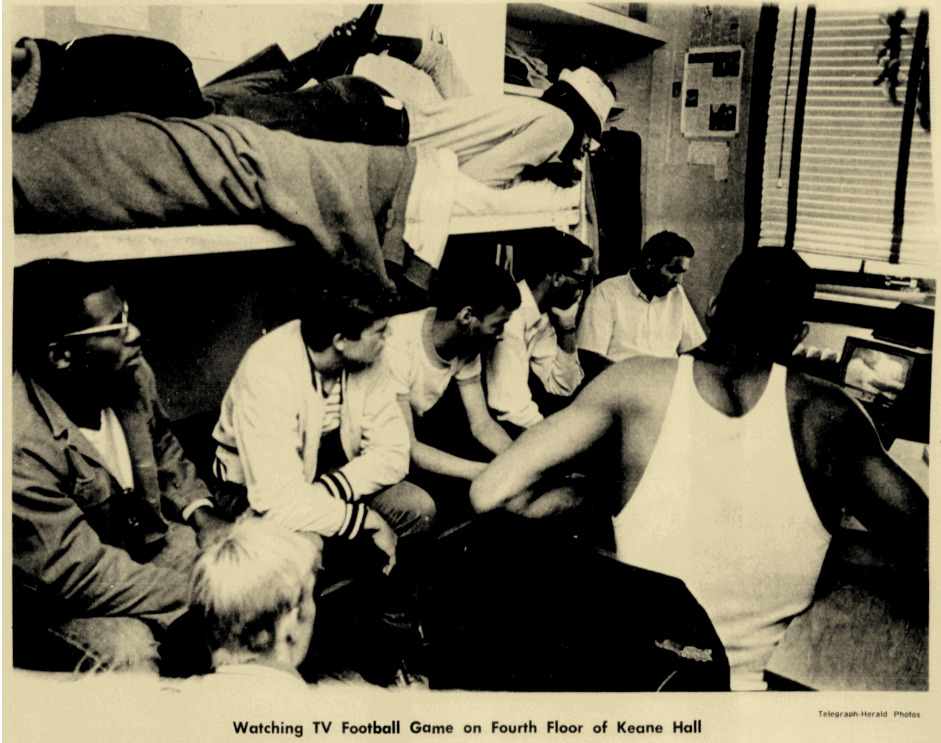The Black Floor

Keane Hall in the mid-twentieth century
In her book, The Black Revolution on Campus, Martha Biondi explains that when black enrollment in colleges and universities began to rise across the country, minority students were often sprinkled in dormitories across campuses. It was nerve-racking for to them live surrounded by potentially hostile white students, with very little connection to fellow black students (Biondi, 17). After several personal conflicts between black and white students during the 1967 school year, all of Loras’ black students requested they be permitted to live together in one place to create a feeling of unity and safety on campus. In the fall of 1968, a group of about 16 black and 35 supportive white students began living together on the fourth floor of Keane Hall, which became known as “The Black Floor” (1).
During an interview in April of 2022, Rev. Eugene Kutsch, Dean of Men, recalled when the students presented him with their initial idea to live together.
“One of the things that happened, one of the black students who was a real leader… and he said, ‘Would it be possible for the black students to live on the fourth floor? We have the white students who are interested come and join us.’ And I asked them there for their reasons. And I won't talk about exactly what they told me, but I think was pretty much [that] they have their own space, you know, and they have a place where they were very comfortable with each other. And so I said it would be okay.”
Reverend Eugene Kutsch
Greg Rhodes, a black student councilor and senior residing on the fourth floor told the Telegraph Herald, “We have formed to educate ourselves and the white campus. We have come together for identity purposes, so we can identify with ourselves." Ron Thomas, resident of the floor, eloquently explained, “Black power is the black man accepting himself as black. That is, he is proud of being black. He accepts his skin, his superficialities. Black power is black people coming together, controlling their own economic, social, and political aspects of life” (1).
Black Power rhetoric is sometimes misinterpreted as “reverse racism” as it can appear to reinforce segregation (Biondi, 19). However, Biondi argues that Black Power advocates were not rejecting desegregation but redefining it. She eloquently explains that desegregation is not colorblind—but pluralistic (Biondi, 4). Up until this point in American history, integration was on purely white terms. They were expected to give up their identities as black and take up purely white customs. Therefore, many black students felt that integration was equivalent to racial assimilation. Young black activists argued that integration is a two-way practice (Biondi, 20-1). This was often misinterpreted as segregationist, as it continues to be today.
Reactions to the black floor were mixed. Many people felt like the college was encouraging segregation on its campus. Kutsch acknowledged these concerns in the Telegraph Herald, saying that "any student should feel at home at Loras. I did not think about it in terms of segregation." The students wanted to create a space to get away from discrimination on campus and in the city of Dubuque. Kutsch also tied hesitancy surrounding the black floor to the bigger picture, saying "The problem on this campus is not a misunderstanding of black power. The problem is the white racism—an unwillingness to accept black people. But Loras is just a reflection of the rest of America, and America is racist” (1).
The 35 white students who resided with the black students were members of the “Students for Human Rights” organization, which they established to support their black peers on campus. They embraced multiculturism by engaging and learning from one another. Mr. Hugh Nocton, Assistant Dean, explained that the results of the black floor are "ironic," stating, "The black students seem much more open with the whites on campus, and white students have learned the meaning of community, brotherhood, and loyalty from the black students. Black power and the black students here have taught the white students about white America" (3). The community forged by these black and white Loras students is a profound example of what integration could look like if it was treated as a two-way process.
Click purple resource titles to view online or make an appointment to visit the archive!
Cited Sources |
|
![[1970 Purgold] Image of Rev. Kutsch.png [1970 Purgold] Image of Rev. Kutsch.png](https://400768.2mxaj.group/files/fullsize/74a2473a41f7affe637b80a6124c779d.jpg)
